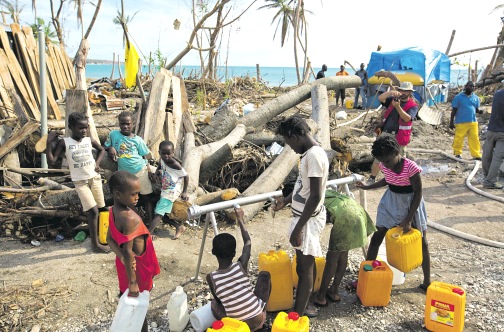COTEAUX, Haiti (AP) — It’s been nearly a month since Hurricane Matthew tore through southern Haiti, and people like Kettley Rosier and many of her neighbors still have to spend their meagre savings to buy drinking water.
Reservoirs and pipe networks that people depend on for water across the country’s southern peninsula were contaminated or damaged by a combination of ocean storm surge and sewage from the overflowing latrines that are commonly used in rural Haiti. Wells were submerged by rivers that topped their banks and carried cholera bacteria, which epidemiologists suspect has sickened thousands of people since the Category 4 hurricane.
“We’re tired of this,” Rosier said on a recent morning, scratching at skin irritated after bathing with murky well water. For drinking water, she has to buy small bags from street vendors. “God only knows when the good water will come back.”
An army of international relief teams have put enormous work into cleaning contaminated wells, distributing millions of water-purifying tablets and installing water treatment stations in areas that bore the worst of the hurricane. But it’s not yet enough.
Roughly 90 per cent of the piped water supply systems in southwest Haiti were damaged by the storm that struck October 4, according to Haiti’s National Water and Sanitation Directorate. Communal and private wells were contaminated across three provinces.
The extensive contamination of wells and the large amount of rain dumped by Hurricane Matthew created ideal conditions for spreading waterborne diseases including cholera, which causes rapid dehydration and can kill a human within hours if not treated. Authorities and aid groups say they have detected fecal matter and E coli bacteria in drinking supplies.
“A lot of sources are contaminated at the moment,” said Leo Tremblay, a Canadian water and sanitation coordinator with Doctors Without Borders, which is overseeing a cholera treatment centre in the village of Port-a-Piment and has sent staff by donkey to provide aid to remote mountain villages.
The humanitarian group said Friday its teams were seeing “deteriorating health conditions” in heavily hit zones.
In the devastated city of Jeremie, two water purification stations operated by French government emergency workers have so far transformed river water into 450,000 liters of potable water. But international specialists say many communities right along shorelines still aren’t getting adequate supplies.
Complicating matters, some storm victims are taking chances with their health.
In parts of the city of Les Cayes, people could be seen drinking straight from a contaminated well, bypassing treated supplies set up by a South Carolina-based organization known as Water Mission.
“Our bodies are used to dirty water. Maybe if we go to that new water place we’ll fall sick,” said Ephraim Bernard, a jobless 24-year-old standing by the contaminated well, located by a trash pit where three people were openly defecating on a recent morning.
Cholera was likely introduced to Haiti in 2010 by UN peacekeepers from Nepal and it has killed about 10,000 people and sickened more than 800,000. Haitians are generally aware of the risk, and families often go to great lengths to ensure they stay healthy.
Yvette Dorival, a 22-year-old who lives in hills above the devastated beach town of Port Salut, is making two-hour treks three times a day to carry a jug filled at a water treatment site set up by Bomberos Unidos Sin Fronteras, a Spanish aid group. On the way, she passed Swiss Humanitarian Aid workers patching up a splintered water supply system.
“Why is it I only see the blan out here working hard to get water to us Haitians?” she asked, using the Creole word for foreigners.
There are some locals pushing to increase supplies, including Georges Edouard Elie, a businessman who owns a reverse osmosis plant in Les Cayes that produces Eau Kay water for a string of south coast settlements He is working with Arkansas-based nonprofit Heifer International to install a network of 1,500-gallon tanks that can be fed by water trucks.
Source: http://www.jamaicaobserver.com/news/-We-re-tired-of-this-_78993 #Caribbean #Haiti



